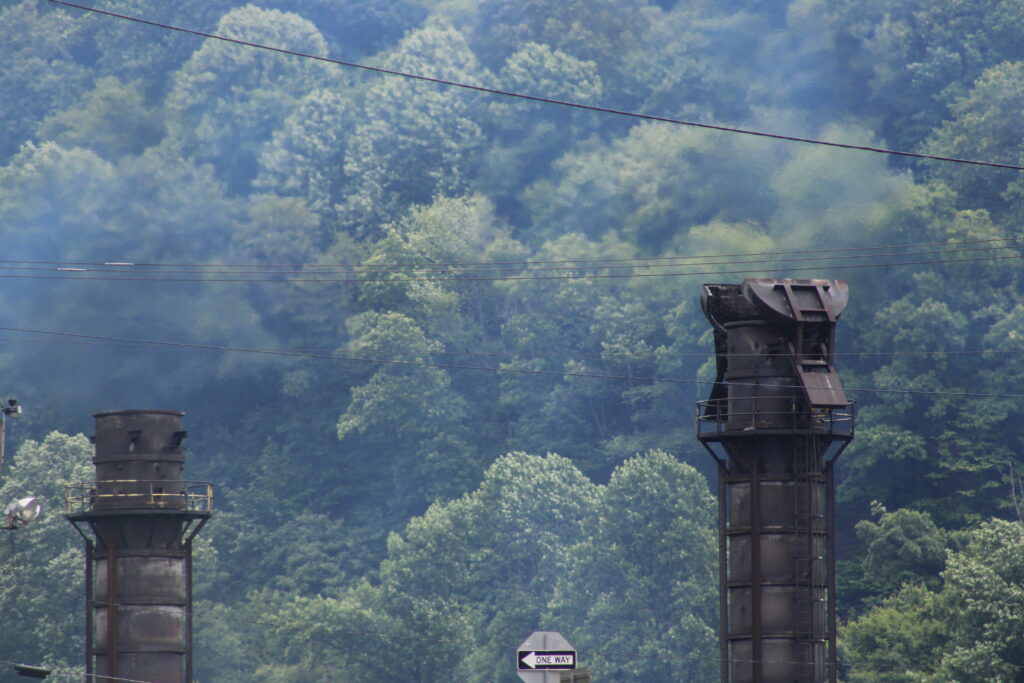Emissions from a coal processing plant in Buchanan County. (Charlie Paullin/Virginia Mercury)
Virginia’s largest producer of natural gas is expanding its regional headquarters in the Southwest region of the state. Natural gas can be derived from coal bed methane, a potent greenhouse gas driving climate change which, in Virginia, is emitted through mining in the state’s coalfields.
On Friday, CNX Resources held a ribbon cutting to celebrate moving its regional headquarters from Claypool Hill in Tazewell County a few miles north to the Richlands Professional Building in the town of Richlands within the same county.
“CNX brings to life our vision for an all-American, all-of-the-above approach to fueling Virginia’s unprecedented economic growth and energy needs, leveraging Southwest Virginia’s rich coal mines to produce abundant, affordable, and lower emissions natural gas,” Republican Gov. Glenn Youngkin said, referencing his energy plan that calls for continued use of natural gas.
The move, announced in 2023, was made possible with a $900,000 loan from the Virginia Coalfield Economic Development Authority, a regional authority the Virginia legislature created in 1988 to diversify the economy in the state’s 13 coal-producing counties in the region.
The funds for the loan come from a severance tax Tazewell county assed on coal and natural gas companies, explained Youngkin’s press secretary Christian Martinez.
The loan will go to the Tazewell County Industrial Development Authority, which will use $500,000 to purchase about 121 acres of CNX Resources property near Tazewell High School. The IDA will also give the remaining $400,000 to CNX Resources to pay for upgrades to the Richlands Professional Building, where CNX Resources has entered into a 15-year lease.
The expansion will house 75 employees and bring on eight new ones, while also increasing the Richland’s Professional Building square footage by 85%. The loan must be repaid within five years, but the $400,000 is forgivable if CNX Resources employs at least 75 employees full-time with an average annual salary of $100,000 by the fifth anniversary of the loan.
Jonathan Belcher, executive director of the VCEDA, said in a statement the authority was “pleased” to work with a “great” company that demonstrates why the region is “such a great place to do business and expand.”
CNX Resources, headquartered in Pittsburgh with operations also in Ohio, West Virginia and across the counties of Buchanan, Russell and Tazewell in Virginia, produces natural gas from the Marcellus and Utica shales of Appalachia.
The company, which operates in Virginia as Pocahontas Gas, produced around 52% of all natural gas in the state in 2023, mostly in Buchanan County, Virginia Energy spokeswoman Tarah Kesterson stated. Natural gas across the state that year had an estimated value of $217 million and accounted for 54% of in-state electricity generation, she added.
The year prior, in 2022, about 83% of that natural gas came from coal beds through the extraction of methane from coal, a process known as coalbed methane, or CBM, according to the Energy Information Administration. Those levels accounted for 10% of the county’s coal-bed methane.
Methane is 25 times stronger than carbon dioxide at trapping heat in the atmosphere, and can also come in the form of coal mine methane, or CMM, produced by mining operations releasing it as a safety measure to prevent explosions during underground digging for coal.
Brian Aiello is a spokesperson for CNX Resources, which was part of a 2023 state workgroup that suggested Virginia could create incentives for CMM capture to stimulate economic activity and reduce emissions that would otherwise escape into the atmosphere. The headquarters’ move “signifies our commitment to the region and aligns with our ongoing efforts to drive economic progress while reducing emissions in the Commonwealth,” Aiello stated.
On the topic of CMM incentives, Aiello said the company was “pleased that efforts at both the state and federal level to encourage the capture and beneficial use of coal mine methane continue to move forward,” adding that such projects are “an environmental and economic win-win for the region.”
Virginia received funding from the U.S. Environmental Protection Agency over the summer to capture coal mine methane. Sen. Travis Hackworth, R-Tazewell, introduced a bill this past session that would have allowed CMM to count as a renewable energy source, but it got carried over to the 2025 session amid concern that it wouldn’t be a clean energy source and could continue incentivizing methane.
The International Panel on Climate Change, which links human created emissions to climate change, said that one ton of methane has a planet warming potential over a 100-year time frame that is equal to 28 to 36 tons of carbon dioxide emissions. Scientists have long linked climate change with increased severe weather events but the extent of its impact is unknown.
GET THE MORNING HEADLINES DELIVERED TO YOUR INBOX

